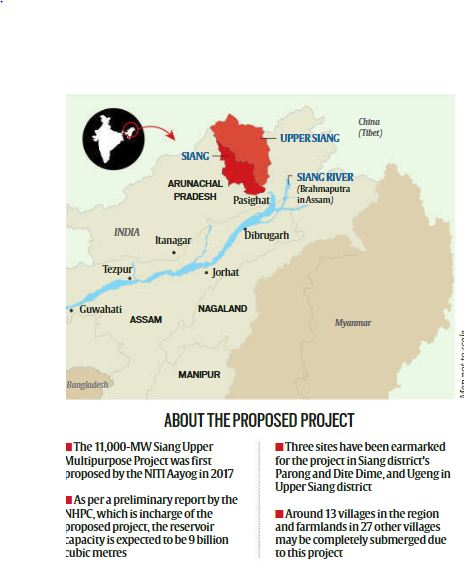December 28, 2024
Siang Upper Multipurpose Project:
The Siang Upper Multipurpose Hydroelectric Project is a proposed dam and hydroelectric power project on the Siang River, the Indian extension of the Brahmaputra River, in the northeastern state of Arunachal Pradesh. This ambitious project aims to address India’s growing energy demands while tapping into the hydropower potential of the Siang River.
Key Facts
- Location: Siang River, Arunachal Pradesh, India.
- Proposed by: National Hydroelectric Power Corporation (NHPC).
- Capacity: Initially proposed at 10,000 MW (later revised estimates suggest a combined capacity of over 18,000 MW across Siang projects).
- Components: Includes a series of dams, storage reservoirs, and hydroelectric generation facilities.
- Significance: The project is part of India’s strategy to harness the immense hydropower potential of the Brahmaputra basin, estimated at over 50,000 MW.
History:
- Conceptualization:
- First proposed in the 1980s, the project was envisioned to utilize Arunachal Pradesh’s significant hydropower resources.
- Initially planned as a single mega-dam, the project later evolved into a series of dams (Upper, Middle, and Lower Siang).
- Geopolitical Context:
- The Siang River originates in Tibet as the Yarlung Tsangpo. Its flow into India makes the project sensitive due to India’s downstream relationship with China.
- Concerns about upstream Chinese projects on the Yarlung Tsangpo (e.g., dam constructions and potential diversions) have driven India to prioritize hydropower projects in the region.
- Environmental Reviews:
- The project has faced scrutiny from environmentalists and civil society organizations due to its potential impacts on biodiversity, tribal communities, and seismic risks.
- Revisions and Delays:
- Over the decades, the project has undergone multiple redesigns and delays due to environmental clearances, opposition, and political sensitivities.
Key Issues and Challenges:
1. Environmental Concerns:
- Biodiversity Threats:
The Siang River basin is part of a biodiversity hotspot. Large-scale construction and submergence could threaten rare flora, fauna, and aquatic ecosystems. - Forest Loss:
The project requires significant deforestation, leading to habitat destruction and climate implications. - Sedimentation and Flow Disruption:
Alteration in sediment transport could affect downstream river morphology and ecosystems.
2. Impact on Local Communities:
- Displacement:
The project would submerge vast areas, displacing thousands of indigenous tribal communities who depend on the river for their livelihoods. - Cultural Impacts:
Local tribes like the Adi and Galo communities have deep cultural and spiritual connections with the river.
3. Geopolitical Concerns:
- China’s Role:
China’s upstream projects on the Yarlung Tsangpo pose risks to the water flow into India. Uncoordinated dam building could lead to water scarcity, sudden floods, or ecological damage downstream.
4. Seismic Risks:
- Arunachal Pradesh lies in a high-seismic zone. The construction of mega-dams increases the risk of catastrophic failure in the event of an earthquake.
5. Financial and Logistical Challenges:
- Cost Overruns:
Large infrastructure projects often face delays and cost escalations due to technical and administrative hurdles. - Remote Location:
The rugged terrain and lack of infrastructure in Arunachal Pradesh make construction and transportation challenging.
6. Political and Legal Challenges:
- Protests:
Local opposition, led by environmental activists and tribal groups, has delayed clearances and disrupted project plans. - Regulatory Delays:
Securing environmental and social clearances has been a long-standing bottleneck.
Potential Benefits:
- Hydropower Generation:
Significant capacity to meet India’s renewable energy goals and reduce dependence on fossil fuels. - Flood Mitigation:
Dams can help control floods in downstream areas, particularly in Assam. - Water Security:
Strengthens India’s claim over transboundary river resources amid concerns about Chinese activities. - Economic Development:
Infrastructure development in Arunachal Pradesh could spur local economic growth and connectivity.
Way Forward:
- Community Participation:
Incorporate the concerns of local communities through dialogue and equitable compensation. - Environmental Safeguards:
Adopt stringent measures to minimize ecological impacts and ensure biodiversity conservation. - Geopolitical Coordination:
Work with China to develop a transboundary water-sharing mechanism to prevent unilateral actions. - Seismic Resilience:
Design infrastructure to withstand seismic shocks and prioritize safety. - Smaller Dams:
Consider smaller, decentralized hydroelectric projects as alternatives to mega-dams.
The Siang Upper Multipurpose Project is a testament to India’s ambition to balance energy needs, environmental conservation, and regional development, but its success depends on addressing the myriad challenges it faces.
January 20, 2025
January 14, 2025
January 7, 2025

